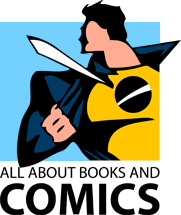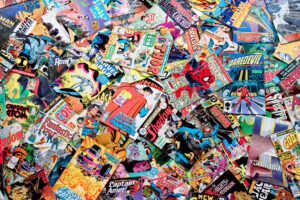The Marvelous Land of Oz #1 ( of 8 ) — Writer: Eric Shanower; Art: Skottie Young
Shanower and Young’s earlier adaptation of the original Wizard was an unexpected hit (i.e., it sold in Marvel Divas numbers in the Direct Market: not bad for a non-superhero kids’-book series); now, they’re venturing into the other Baum Oz books. The appeal here is twofold: Young’s art, which can handle both cartoony/appealing (Tip, the kid who’s the main character at the beginning of this book) and cartoony/creepy (his Jack Pumpkinhead, who’s both scary and oddly noble) with equal aplomb; and Shanower’s script, which manages to keep Baum’s turn-of-the-century rhythms and matter-of-fact descriptions of various magic and wonders, and still condense it all down to comic-book size. Since most readers haven’t read these later episodes, there’s the added advantage of not knowing where the story’s going, and younger readers, especially, should find these fascinating and charming enough to want to read the novels too.
Doom Patrol #4 — (Main Story/20 pgs.): Writer: Keith Giffen; Penciller: Justiniano; Inker: Livesay; (Metal Men story/10 pgs.): Writers: Keith Giffen and J. M. DeMatteis; Art: Kevin Maguire
Worth mentioning here because a lot of you are going to buy it to get the yellow-ring giveaway (you fanboys, you). The main story follows the same pattern as all the other Blackest Night tie-ins (various deceased team members come back and try to kill the current ones); Giffen’s deadpan dialog is sometimes fun, and the art’s detailed and competent enough to give a sense of creeping suspense. However, this is an exceedingly dense comic, in both art and story: the panels and script cram a lot of information into each page, and it’s assumed that we know who all of these people are — a fatal mistake, considering that the ring promotion makes this a tryout book for a lot of new readers. The Metal Men story, with its early-’80s JLA creative team, is more accessible (and Maguire’s art is appealing as ever), but it also packs a lot of material into its even-smaller 10-page space, and it’s only one piece of a longer story. All in all, it’s doubtful that many of the first-time buyers will come back for more.
Haunt #2 — Writer: Robert Kirkman; Layouts: Greg Capullo; Pencils: Ryan Ottley; Inks: Todd McFarlane
This has received a lot of attention, but two issues in it doesn’t seem to be the second coming of… well, anyone, really: it’s a perfectly competent, slightly-above-average superhero book, with Kirkman’s trademark strengths (it’s well-constructed, moves along briskly with lots of action, and has an underlying sense of fun) and weaknesses (it’s got half the comic-book cliches known to man in it). Same for the art: there are a couple of splash pages that are cool, but they could be of Spawn or Spider-Man or any similar character, and the overall design and composition are straight-ahead Image house style. Buy it if it appeals to you, but within a year you’ll probably be bored with it.
Lobo: Highway to Hell #1 (of 2) — Writer: Scott Ian; Art: Sam Kieth
Speaking of boring… now, this is just bad. You’d think a character like Lobo, with an established fan base and approach, would be hard to screw up. Here’s how: get a member of an ancient heavy-metal band to “write” the script, even though he has no idea how to compose a comics page, write dialogue, or sustain a narrative; that way, the character just wanders around, stumbling into scenes that start for no reason and end with no payoff, echoing bits and pieces of previous Lobo stories. Then, get Sam Kieth to draw the thing in, like, 20 different styles, so that sometimes the Main Man looks like his Simon Bisley version, sometimes like The Maxx, sometimes like Alice Cooper and sometimes like something out of a kids’ coloring book. Slap it all together over a weekend in your garage, stick a $6.99 price sticker on it, and you’re good to go. Then, when it tanks, mutter about the economy and how readers these days don’t appreciate classic characters, collect your paychecks, and slink silently into the night.
Doctor Voodoo #2 — Writer: Rick Remender; Artists: Jefte Palo and Gabriel Hardman
For those of you not keeping up, Brother Voodoo is now Earth’s Sorcerer Supreme, and he’s got his own series. No, stop laughing: Marvel’s doing it straight. The problem is, he’s new at the job, so he’s getting his head handed to him by old villains like Nightmare. That’s a logical story choice, and you have to figure that by the end of this first arc he’ll show his voodoo stuff and be victorious, but it also means that in these initial few issues he’s acting like a clueless loser. Add to that the murky, jammed-together and hard-to-follow art and coloring, and it’s doubtful that readers who’ve picked up the first few issues will be attracted enough to come back for more. Next issue: in preparation for battle, he puts on whiteface makeup! No, stop laughing again; I’m not making this up — check the “next issue” blurb on the last page….
Deathlok the Demolisher #1 (of 7) — Writer: Charlie Huston; Art: Lan Medina
This is one of those Deathrace-type future-sf stories, where the media broadcast sporting events that involve the teams actually shooting at and trying to kill each other. Our main character is, of course, a star at this kind of thing, and of course by the end of this first issue he’s blown to bits (so that, presumably, by next issue he can turn into Deathlok). Both the story and the visuals are fine, but (a) we’ve seen this kind of thing a million times before, and (b) none of it has any connection to previous versions of Deathlok, or to Marvel continuity generally, which means that by the end of its run this book will be selling somewhere between 5,000 and 10,000 copies per issue. The character will then disappear until the next time Marvel wants to retain the rights to the name and costume, and revives him in yet another pointless mini-series.
Black Widow: Deadly Origin #1 (of 4) — Writer: Paul Cornell; Penciler: Tom Raney; Inker: Scott Hanna
The same keep-the-rights deal is operating here, but this has the advantage of Cornell (whose recent Captain Britain was low-selling but critically-appreciated). Not a great start, though — it uses the cliche of motivating the character by “shockingly” killing an old friend of hers (one whom I’d swear has been similarly killed at least twice before), and the art, which for Natasha needs to walk the tightrope between appealingly-sexy and kick-ass empowering, doesn’t particularly stand out at either one.
The Great Ten #1 (of 10) — Writer: Tony Bedard; Penciller: Scott McDaniel; Inker: Andy Owens
A book about Chinese superheroes you’ve never heard of. Ten of them. For ten issues. Why? Because DC Comics hates you.
Phil Mateer


